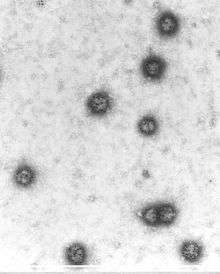Akabane virus
| Akabane virus | |
|---|---|
 | |
| Transmission electron micrograph of the Akabane virus | |
| Virus classification | |
| Group: | Group V ((-)ssRNA) |
| Family: | Bunyaviridae |
| Genus: | Orthobunyavirus |
| Species: | Akabane virus |
The Akabane virus is an insect-transmitted virus that causes congenital abnormalities of the central nervous systems in ruminants.[1][2]
Background
Virus
Two viruses, both arthropod borne, have been implicated in the cause of these congenital defects: Akabane virus, named after the district in Japan where it was first found, and Aino virus. Generally, both these viruses are referred to as Akabane virus.
Disease
Akabane virus does not, as far as is known, cause any overt sign of disease, in either young or adult animals. Its effect is on the fetus and the conditions which result in the disease in the fetus may be summarised as follows- 1. The pregnant dam has not previously had exposure to the virus and therefore has no specific immunity and becomes infected, and 2. The virus passes through the placenta and infects the calf, specifically the calf's central nervous system (CNS) where it may cause varying amounts of damage. Affected calves may be blind, have difficulty in suckling, walking or learning herd behaviour, etc. Other species may become infected. These include buffalo, camels, horses, sheep, goats and dogs. The disease in these hosts is not commonly observed and, apart from in buffalo, is probably not a particularly important infection.
Malformation of the joints, brain, spine and jaw are common in affected newborn animals. Abortion may also occur if damage to the fetus is severe.[3]
Infection
As Akabane is an infectious disease, it is necessary to know how the virus is transmitted if the infection is to be combatted. It has been shown that animals that have been infected with Akabane virus are found mostly in those parts of Australia which have the blood sucking midge "Culicoides brevitarsis." This, and the fact that the Akabane virus has been isolated from this midge, has led to the supposition that it is C. brevitarsis which is responsible for the spread of the disease. Normally, in areas where the midge is prevalent, no signs of the disease is seen because the dams are immune. When suitable weather conditions (such as warm humid summers) prevail, the virus-carrying midge can extend its normal range into areas with susceptible animals. If these cattle have not previously been infected (often the younger animals) then it can be expected that the disease will make an appearance in the calving season.
Diagnosis and treatment
Diagnosis can often be made on the basis of clinical signs and can be confirmed by demonstration of antibody in the blood of the calf or in the blood of the dam thanks to an ELISA. Viral isolation can also be attempted with immunofluorescence or PCR.[3]
Treatment of Akabane disease, like most viral diseases, is impractical. In mild cases, the calf may be saved by assisting it in suckling, but it is rarely worth the trouble. Normal practice is to destroy the affected calf.
Vaccination is used to control the spread of disease. Control of the insect vectors is advisable if possible, but often difficult to implement.[3]
Conclusion
Akabane disease is an important disease in those areas which are subject to only an occasional influx of C. brevitarsis. It is a useful method for obtaining information about the spread and persistence of C. brevitarsis which may be a possible vector for the insect borne viral disease "Bluetongue" – should Bluetongue ever enter Australia.
Cases of outbreaks
Nearly all cattle breeders in the northern part of Australia, including north-eastern New South Wales, have experienced congenital defects in calves, and more specifically, those congenital defects that give rise to calves known as curly, imbecile, silly or dummy calves. A small percentage of these are, no doubt, the result of non-infectious causes, perhaps inherited or the result of some effect during gestation.
A European outbreak of a novel Orthobunyavirus began in 2011. The virus was initially isolated near Schmallenberg in Germany, and has been informally named Schmallenberg virus (SBV).[4][5][6] Schmallenberg virus falls in the Simbu serogroup of Orthobunyaviruses, in which the Aino and Akabane viruses are also grouped; as of January 2013, it is considered to be most closely related to the Sathuperi and Douglas viruses.[7]
References
- ↑ Akabane. animalhealthaustralia.com.au
- ↑ Akabane Disease. Iowa State University. September 2009
- 1 2 3 Akabane Virus reviewed and published by WikiVet, accessed 10 October 2011.
- ↑ Schmallenberg-Virus: Gefahr für Tiere in Europa. augsburger-allgemeine.de. 27 January 2012
- ↑ Schmallenberg-Virus. fli.bund.de
- ↑ Schmallenberg virus. Department for Environment, Food & Rural Affairs. UK Government
- ↑ Friedrich-Loeffler-Institut: Schmallenberg virus (SBV) (updated 31 January 2013; accessed 5 February 2013)
External links
- Merck veterinary manual
- www.scienceimage.csiro.au/index.cfm?event=site.image.detail&id=1310
- Couch A.J. (1984) Akabane Virus. Australian Red Poll Society Newsletter 92: 22–23